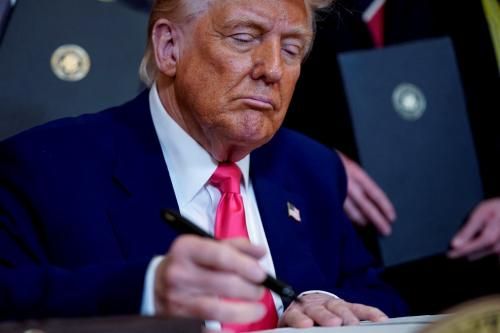This Brookings Center on Regulations and Markets – Fireside chat with Michael Allegretti, Chief Strategy Officer at Rubicon, was recorded on November 6, 2020.
Sanjay Patnaik, director of the Center on Regulation and Markets and Bernard L. Schwartz Chair in Economic Policy Development in Economic Studies, recently sat down with Michael Allegretti, Chief Strategy Officer of Rubicon. They discussed a variety of topics related to the waste management industry, including Rubicon’s business model, regulation of the waste management sector and recent developments in recycling. Here are some highlights:
How Rubicon got its start and how it’s regulated
Rubicon began in 2008 as a software startup providing smart waste and recycling solutions to both cities and businesses. Rubicon’s business model is to sell its waste management technology directly to businesses, individuals, and city governments. According to Mr. Allegretti, the waste management industry is largely regulated at the city and county levels, and, to a lesser degree, at the state level. Their SmartCity team specifically interacts with governments, and the company is in the process of rolling out its Reg Watch program meant to help customers understand if they’re in compliance with the local laws in their jurisdiction.
How China’s national sword recycling policy impacted the U.S. waste management industry
When China instituted its national sword policy in 2018, the country stated it would no longer import low-grade recyclables from other countries -in short, China would no longer accept other countries’ trash. Unsurprisingly, the move left the American waste management industry without a buyer for many of its recyclables, as no other country had sufficient recycling infrastructure. As a remedy, Mr. Allegretti proposes that the U.S. build a stronger recycling infrastructure while financially breaking even or even generating profit. At a minimum, universal labeling for recyclables would allow citizens across different localities to avoid recycling contamination.
EffectIve models to expand recycling capacity
Segmentation and avoiding contamination have been key to building a profitable recycling market. The more content there is in a single stream recycling bin, the greater the chance of producing contaminated recyclables. Mr. Allegretti argues that landfills had incentives to promote this model, since contaminated recyclables lead to more products that go to landfills. As governments pass bills banning various materials, the private sector has begun developing packaging that doesn’t harm the environment.
The most common waste management inefficiencies among haulers and municipalities
The simple answer: routing. Mr. Allegretti brings up Atlanta as an example, where Rubicon optimized the way fleets run by increasing pick up days from four to five times a week while reducing the length of each route. This has brought down overtime costs and reduced emissions produced on the routes. Consumer behavior has also been a major influence on the market, as consumer sentiment can drive businesses to source their materials more responsibly and focus on public environmental concerns.
To hear Mr. Allegretti’s complete comments, watch the fireside chat here:
The views expressed herein are those solely of the speakers and do not reflect the position of The Brookings Institution.
-
Acknowledgements and disclosures
Cayli Baker provided editorial assistance for this blog post.
The Brookings Institution is committed to quality, independence, and impact.
We are supported by a diverse array of funders. In line with our values and policies, each Brookings publication represents the sole views of its author(s).








Commentary
Disrupting the waste management industry through technology: Insights from Rubicon
January 14, 2021